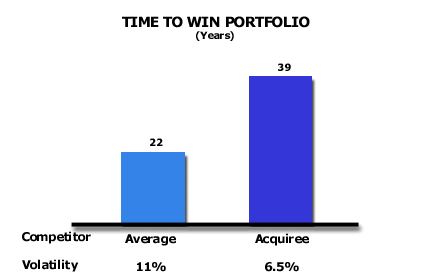Analysis 63: Time to Win Acquiree’s Portfolio of Customers
EXHIBITS:

| HOW TO INTERPRET THE ANALYSIS: This exhibit shows the time it would take for the company to gain the customer sales volume of a potential acquiree. This time is related to the Negative Volatility of the potential acquiree. As an industry matures, an increasing percentage of its Negative Volatility is due to Failure. The incumbent supplier must Fail in the customer relationship in order to open that relationship to a competing supplier. "Wins" in mature markets account for a relatively small portion of total Volatility. In this exhibit, if the company were to acquire the average competitor, that average competitor would have Negative Volatility of 11% per year. This would enable the company to gain its customer portfolio over a period of 22 years. It would take 22 years because the company does not gain all of the volume lost by the average competitor. It would expect to gain only its current market share of that volume. In the right hand bar, the potential acquiree in this case is stronger than the average competitor. Its Negative Volatility runs at 6.5% per annum. Acquiring its customer portfolio by competing for it in the marketplace would take 39 years. Either one of these results, 22 years for the average competitor or 39 years for the potential acquiree, means that gaining these competitors' volume in normal competition has become impractical. If the company wishes to gain the customer portfolio of the potential acquiree, it has only one choice, the acquisition of the competitor.
PURPOSE: This analysis quantifies the time it would take the company to compete for and win the customer portfolio of its acquisition target, considering the Negative Volatility of the potential acquiree. APPROACH: The marketing and sales functions evaluate the Negative Volatility of the potential acquiree. They estimate how much annual volume leaves that acquiree every year. It then evaluates the rate at which the company itself gains the volume that the potential acquiree lost. That is, it evaluates the one-on-one competition between the company and its competition for the acquiree's lost volume. From this analysis, the marketing and sales function projects the number of years it would take for the company to win the acquiree's portfolio of customers. In a difficult market, it would often take many years to win the customer portfolio of a potential acquiree. This happens for two reasons. First, volatility tends to be low in hostile marketplaces. Second, and just as importantly, the better companies in the marketplace have much lower Negative Volatility than does the average competitor in the marketplace. As a result, a campaign to win away volume held by a solid performer who might be the acquiree, will require many more years than average. |
|
Recommended Reading |
| For a greater overall perspective on this subject, we recommend the following related items:
Analyses:
Symptoms and Implications: Symptoms developing in the market that would suggest the need for this analysis. Perspectives: Conclusions we have reached as a result of our long-term study and observations.
|
